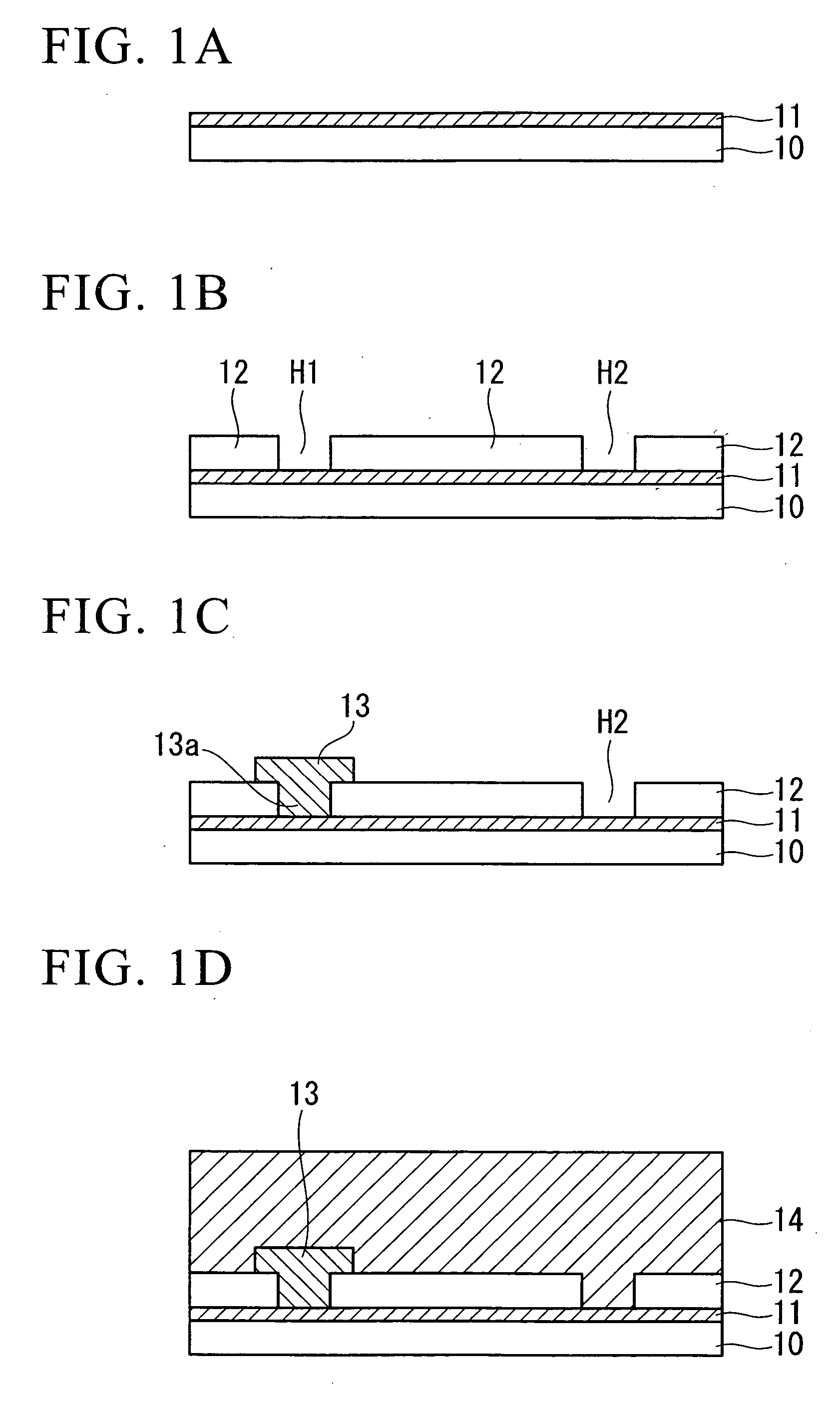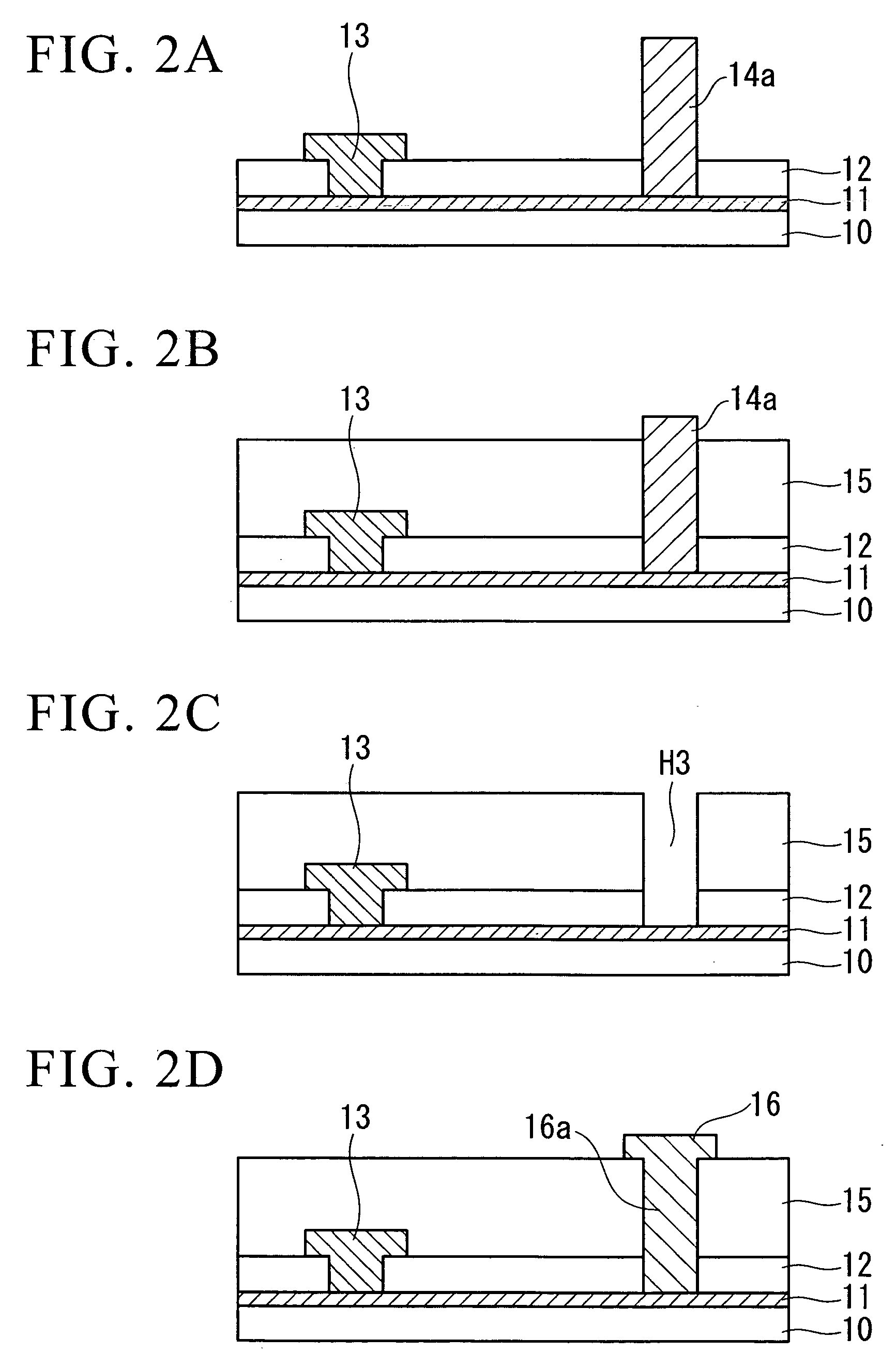Method of forming multilayer interconnection structure, and manufacturing method for multilayer wiring boards
a manufacturing method and interconnection technology, applied in the direction of resist details, semiconductor/solid-state device details, printed circuit manufacturing, etc., can solve the problems of increasing contact resistance or non, increasing the degree of thinning of the film, and obtaining devices that may have a difference in electric characteristics, etc., to achieve high-reliability multi-layer wiring boards
- Summary
- Abstract
- Description
- Claims
- Application Information
AI Technical Summary
Benefits of technology
Problems solved by technology
Method used
Image
Examples
first embodiment
[0033] (First Embodiment)
[0034] First is a description of a manufacturing method for multilayer wiring boards according to a first embodiment of the present invention, with reference to FIG. 1A to FIG. 2D. FIG. 1A to FIG. 2D show examples where the present invention is applied to a step of laminating three wiring layers on a substrate. In all drawings hereunder, the film thicknesses and dimensional proportions of the respective components are appropriately changed for clarity.
[0035] In the present embodiment, firstly as shown in FIG. 1A, a wiring layer 11 is formed on the surface of a substrate 10 such as a semiconductor substrate on which an insulating film is formed, or an insulating substrate made of glass or plastic, using a well-known method.
[0036] Next, as shown in FIG 1B, an interlayer insulating film 12 having openings H1 and H2 is formed in a predetermined position on the wiring layer 11. The interlayer insulating film 12 can be formed by a plasma CVD method using TEOS (t...
second embodiment
[0049] (Second Embodiment)
[0050] Next is a description of a method of forming a multilayer interconnection structure according to a second embodiment of the present invention, with reference to FIG. 3A to FIG. 5B. FIG. 3A to FIG. 5B show examples where the present invention is applied to a step of laminating three wiring layers on a substrate. In the present embodiment, the description is related to a method of forming a multilayer interconnection structure where a first layer and a third layer become conductive, the first layer and a second layer become conductive, and the second layer and the third layer become conductive.
[0051] In the present embodiment, firstly as shown in FIG. 3A, a wiring layer 21 is formed on the surface of a substrate 10 made of glass or plastic, using a well-known method. On the wiring layer 21, mask pillars (mask material) 22 are formed in positions for forming openings H4 and H5 described later. The mask pillars 22 are formed by selectively applying liqu...
third embodiment
[0063] (Third Embodiment)
[0064] Next is a description of a manufacturing method for multilayer wiring boards according to a third embodiment of the present invention, with reference to FIG. 6A to FIG. 8B. FIG. 6A to FIG. 7C show examples where the present invention is applied to a step of laminating three wiring layers on a substrate. In the present embodiment, the description is related to a method of forming a multilayer interconnection structure where a first layer and a third layer become conductive, and the first layer and a second layer become conductive.
[0065] In the present embodiment, firstly as shown in FIG. 6A, a wiring layer 31 is formed on the surface of a substrate 30 made of glass or plastic, using a well-known method. On the wiring layer 31, a mask pillar (mask material) 32 is formed in the position for forming an opening H8 described later. The mask pillar 32 is formed by selectively applying liquid organic material such as a resist or the like and solidifying this...
PUM
 Login to View More
Login to View More Abstract
Description
Claims
Application Information
 Login to View More
Login to View More - R&D
- Intellectual Property
- Life Sciences
- Materials
- Tech Scout
- Unparalleled Data Quality
- Higher Quality Content
- 60% Fewer Hallucinations
Browse by: Latest US Patents, China's latest patents, Technical Efficacy Thesaurus, Application Domain, Technology Topic, Popular Technical Reports.
© 2025 PatSnap. All rights reserved.Legal|Privacy policy|Modern Slavery Act Transparency Statement|Sitemap|About US| Contact US: help@patsnap.com



